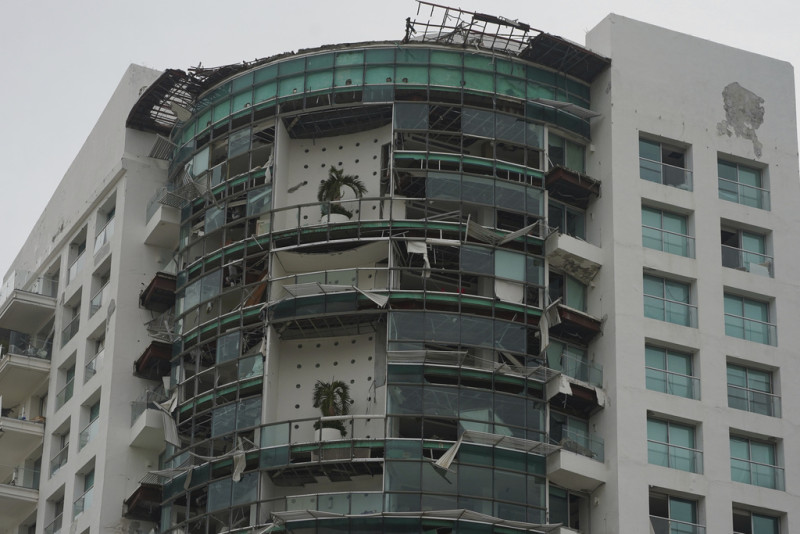So far, the authorities have not reported any casualties – Luxury hotels and shopping malls were damaged,
The famous spa town of Acapulco, in southwestern Mexico, suffered extensive damage and remained shut out from the rest of the world last night, while it was about to complete 24 hours after it was hit by a strong typhoon.
There were no flights, no bus routes, an AFP photojournalist found after the passage of Otis, with winds of up to 315 kilometers per hour. There was also no internet access, no electricity, he added. He had to leave the tourist magnet to be able to broadcast the images he took.
So far, the authorities they have not spoken of victims.
The situation was particularly difficult for tourists and visitors, who could neither leave nor communicate with their relatives.
Early footage and snapshots from the city showed luxury hotels and shopping malls damaged, some with only their concrete structures left, and scenes of looting.
More images coming out of Acapulco. Still no info on casualties….💔 #HurricaneOtis #HurracanOtis #Otis #Acapulco #Mexico pic.twitter.com/UyPClCKESW
— Volcaholic 🌋 (@volcaholic1) October 26, 2023
Sitlali Portillo, manager of a property that normally welcomes tourists, spoke of “catastrophic damage”. “We have no water, no electricity, but we are safe and sound,” he added, speaking to the Mexican television network Televisa.
The building was shaking “as if there was an earthquake,” he added.
Category 5 hurricane, the highest on the five-point Saffir-Simpson scale, reached the ground shortly after midnight (local time; 09:00 Greek time). It formed and strengthened very quickly, within hours, off the Mexican coast in the Pacific.
As several residents were seized, they sought protection wherever they could.
#Mexico #Acapulco Hurricane Otis aftermath pic.twitter.com/dUzAxR2tHi
— World on Videos (@TheCryptoSapie1) October 26, 2023
Mexican President Andres Manuel Lopez Obrador tried to reach Acapulco by road, but the trip was delayed by a road. The highway was covered by a huge volume of mud, uprooted trees, debris, an AFP team found.
“We will make sure (the road) opens as soon as possible,” he told reporters who were blocked out with him.
“The most important thing now is to take care of the affected population. There is still no assessment of the damage, because there are no telecommunications,” said the national coordinator of the Civil Protection Laura Velasques to the television service of the newspaper Milenio.
As dawn broke yesterday, much of Acapulco, with its nearly 780,000 inhabitants, was without power due to a precautionary outage, according to media reports.
The Federal Electricity Commission (CFE, public) assured that power was gradually restored to about 40% of its 504,000 customers in the Acapulco region that were affected.
After making landfall, the hurricane weakened, as forecasters had predicted.
Paulina, Norma, Patricia, Ingrid
On October 9, 1997, Acapulco was hit by Hurricane Polina, which made landfall as a Category 4. Authorities at the time said more than 200 people had died; it was one of the deadliest natural disasters to hit the country. Mexico in recent decades, excluding strong earthquakes.
Last week, Hurricane Norma claimed the lives of three people a little further north, in the state of Sinaloa.
Between the Pacific and the Gulf of Mexico, many Mexican states are hit by hurricanes from May to October, sometimes into November. About ten recessions each year turn into hurricanes, more or less destructive, depending on where they hit.
In September 2013, Hurricane Ingrid in the Gulf of Mexico and Tropical Storm Manuel in the Pacific Ocean hit the country at the same time. Their interaction caused a “historic” phenomenon, which “had been recorded since 1958”, according to the Mexican authorities, who had made public in that case a casualty count that spoke of 157 deaths, mainly due to landslides.
As the surface temperature of the oceans rises, cyclones or hurricanes (depending on where they occur) become increasingly fierce.
According to the Intergovernmental Panel on Climate Change, extremely strong cyclones (categories 4 and 5) will increase by 10% compared to pre-industrial times if the planet’s temperature rises more than 1.5°C.
Due to sea level rise and coastal inundation, more than a billion people will live in coastal cities at risk by 2050, according to the panel.
Source :Skai
With a wealth of experience honed over 4+ years in journalism, I bring a seasoned voice to the world of news. Currently, I work as a freelance writer and editor, always seeking new opportunities to tell compelling stories in the field of world news.











